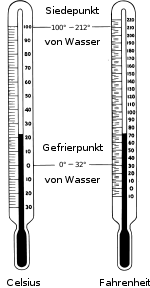Freaks Fun Friday: Water and Ice
I am a freak, I admit it. When I was younger, I actually enjoyed going to school (go ahead, laugh at me) — not because I wanted to meet my friends, but because I loved learning new stuff. It hasn’t changed all that much. I’m still delighted if I manage to smuggle facts into my stories without anyone noticing. at this place, I’ll give you access to my twisted mind. Welcome to a Freak’s Fun Friday.

Temperature Scales in Fahrenheit and Celsius
Do you know how incredibly exciting something unimposing as water is? Not only is it the base for life on Earth, it has a couple of really intriguing properties.
Surely, you all know that materials expand when heated and contract when they cool. All materials do that regardless whether they’re solid (like gold, silver, plumb or iron), liquid (water, alcohol) or gaseous (oxygen, helium). Still, water has a strange property other materials don’t share.
Usually, the molecules of a material move closer to each other, the colder the material gets. Only water is different. Its molecules are closest together at 4°C. After that, they spread out again. That’s the reason why ice swims. There are bigger interspaces which fill with air, keeping it afloat.
In my world Paralan, I used this special property to create different temperature scales for humans and Paralan. For the Celsius-scale, scientists took the difference between the freezing point and the boiling point of water and divided it into 100 parts. That’s the reason why water boils at 100°C. That was a purely arbitrary (There are two more temperature scales on Earth: Kelvin, is using the Celsius scale but with a different zero-point, and Fahrenheit, where the freezing point of water has been defined at 32°F and the spread to the boiling point has been divided into 180 parts).
The Paralan took the point of highest density of water as a zero-point of their scale not the freezing point. Thus, their thermometers differ considerably from humans’. Of course, I only hint at that throughout the novel (any long explanation would have been very boring I think) but I kept track of the temperature on both scales in any given scene. After all, Joloran’s bodily reactions depended on it.
I enjoyed it tremendously. How about you? Have you ever played around with the crazier properties of a material? Maybe in school? Please let me know in the comments.



